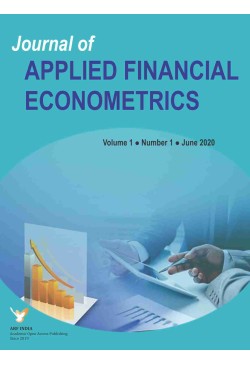
Journal of Applied Financial Econometrics
Frequency :Bi-Annual
ISSN :2583-374X
Peer Reviewed Journal
EVALUATION OF THE PREDICTIVE CAPABILITY OF A TIME-VARYING MARKOV SWITCHING AUTOREGRESSIVE MODEL
Alabi N. O. (2023). Evaluation of the Predictive Capability of A Time-Varying Markov Switching Autoregressive Model. Journal of Applied Financial Econometrics, Vol. 4, No.1, pp. 1-22. https://DOI:10.47509/JAFE.2023.v04i01.01
ECONOMIC GROWTH, DEMOGRAPHY AND SOCIAL CHANGE IN NIGERIA: AN ARDL ANALYSIS
Mukhtar Shuaibu (2023). Economic Growth, Demography and Social Change in Nigeria: An ARDL Analysis. Journal of Applied Financial Econometrics, Vol. 4, No. 1, pp. 23-40. https://DOI:10.47509/JAFE.2023.v04i01.02
VOLATILITY AND TAIL RISK IN THE 2023 BANKING CRISIS: A PORTFOLIO ANALYSIS OF THE U.S. BANKING SECTOR
Omar Barroso Khodr & Mathias Schneid Tessmann (2023). Volatility and Tail Risk in the 2023 Banking Crisis: A Portfolio Analysis of the U.S. Banking Sector. Journal of Applied Financial Econometrics, Vol. 4, No. 1, pp. 41-59. https://DOI:10.47509/JAFE.2023.v04i01.03
MANAGING INTANGIBLE ASSETS FOR SMALL FIRM GROWTH
EFFICIENCY OF MICROFINANCE BANKS AND PERFORMANCE OF MICRO, SMALL AND MEDIUM ENTERPRISES IN SOUTH-WEST NIGERIA